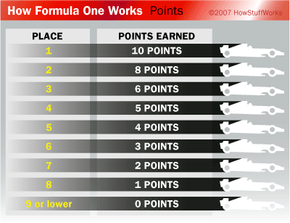Formula One Season
A Formula One season consists of a series of races, or grands prix, held on circuits across the world. The results of each race are combined to determine two annual championships: the Formula One World Drivers' Championship and the Formula One Constructors' Championship. The former celebrates individual performance, and the latter celebrates team performance -- and, ultimately, the performance of the vehicle.
The first auto races were on public roads, not permanent circuits. Public pressure forced race cars off public roads and onto tracks designed just for the sport. Today, the only Formula One race that remains on the street is Monaco. All other races are held on purpose-built tracks designed to handle the needs of high-speed racing.
Advertisement
Any track, be it street or purpose-built, requires its own unique strategy. Monaco, because it is a "tight" street race, forces drivers to slow down considerably. In fact, Monaco is one of the slowest races of the Formula One season. It's also very narrow and bumpy, and it is not unusual for cars to make contact with the barriers. Extra wings are also used on the cars that race at Monaco to make sure enough downforce is created. Because overtaking is almost impossible, securing a good grid position is absolutely essential to securing a victory at Monaco (we'll get into grid positioning later).
A points system decides the champions for a given season. A driver earns points based on how he places in each race. The driver with the most points at the end of the season is crowned champion. The table here summarizes how points are awarded.
Teams earn points using the same system, except they get to total the results of both drivers. So, if the two drivers of a certain team finish first and third in a given race, the team earns 16 points.
The number of races per season can vary because tracks are added or retired all of the time. For example, in 2007, the FIA decided that Germany would no longer host two grands prix and that Japan's Fuji Speedway would be the site of a Formula One race for the first time in 30 years. Generally, however, a season consists of 15 to 17 races, with the majority of the races concentrated in Europe.
Winning in Formula One brings prestige -- and financial rewards. A driver's salary is established by his contract with the team. It's usually a flat fee and requires the driver to participate in a set number of test sessions and make a certain number of appearances on behalf of his sponsors. On top of that base salary, a driver can earn a bonus -- perhaps $150,000 or so -- for winning a race. He can also earn a bonus for winning the Driver's Championship. Then there's merchandising and endorsements. Michael Schumacher, who earns an estimated $30 million a year, is one of the highest-paid sportsmen in the world.
Of course, it's not just the driver who gets to cash in. Formula One teams also enjoy the spoils of victory. The amount a team earns from the sport's television rights is dependent on where it finishes in the title chase.
Winners of every grand prix receive a trophy. Then, there's the Championship Trophy, which is given to the driver and the team with the most points at the end of the season. The Championship Trophy is given out in December at the FIA awards ceremony in Monte Carlo.
Each grand prix is a major undertaking for a team. Read on to find out exactly what happens during a grand prix weekend.
